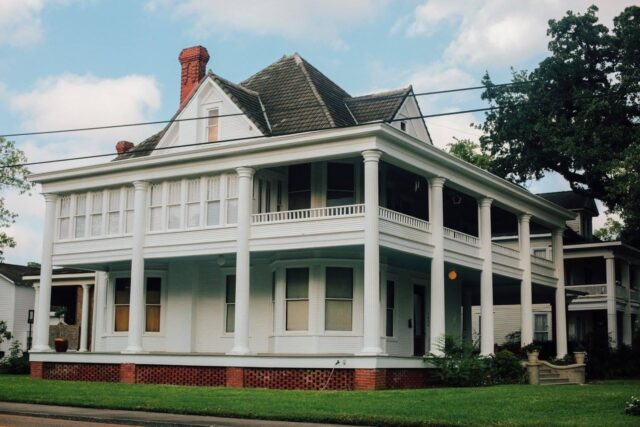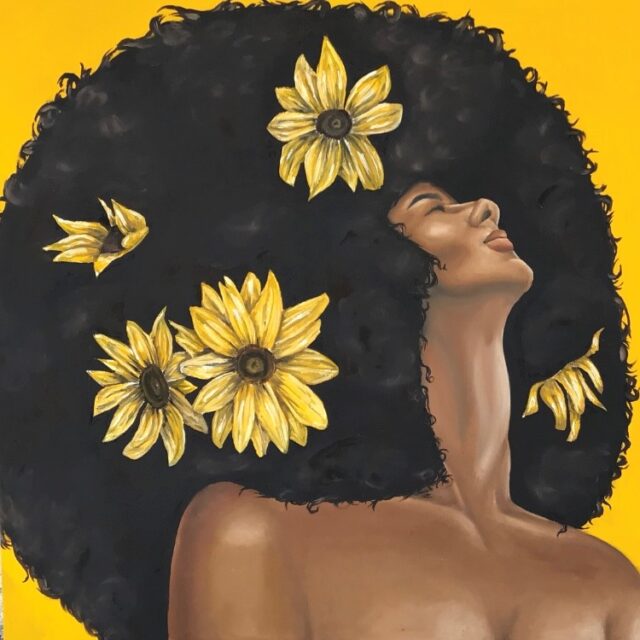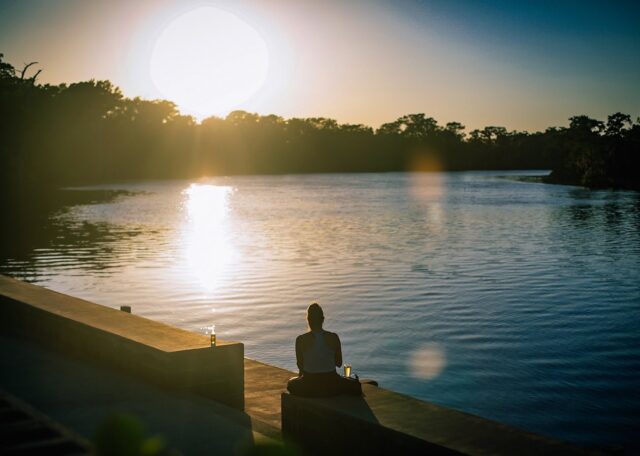Latest
Art in the Aftermath
Paused by a pandemic and battered by a hurricane, Lake Charles looks ahead
Published: September 25, 2020
Last Updated: September 25, 2020
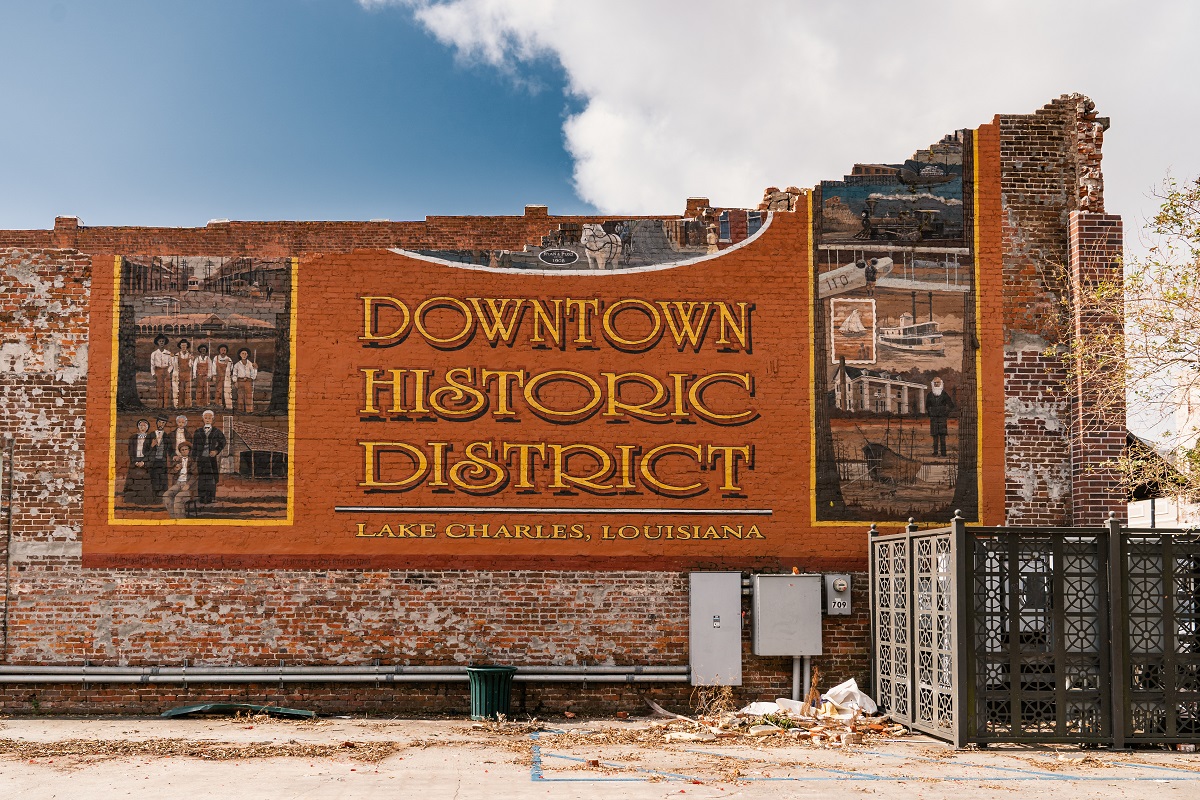
Chad Moreno / Killer Photography
Damage from Hurricane Laura in downtown Lake Charles.
Places change from age or industry, gentrification or migration. Disasters do the job quickly. On the morning of August 27, 2020, Hurricane Laura whipped through southwest Louisiana and displaced nearly half a million residents. Online, where social media acted as a hub and haven, those affected shared images of corkscrewed trees and crumbling housefronts. “We have to do all we can to ensure the rest of the nation understands the scope of the destruction in Louisiana,” US Representative Mike Johnson of Louisiana’s Fourth District told nola.com. Media attention leads to resources for rebuilding, and many in the region worry that they’ll soon be forgotten, another casualty of the 24-hour news cycle. But another responsibility weighs on community leaders: to envision the city and the rest of southwest Louisiana on the other side of this catastrophe. “Lake Charles was a cow town, a sawmill town, a railroad town, a rice town, [and] a market town long before it became a petrochemical town,” wrote Adley J. Cormier, local historian and author of Lost Lake Charles, in a recent Facebook post. “After 2020, it will be another version of itself.”
With its short and deep connection to the Gulf, Lake Charles will undoubtedly remain industrious—and industrial. The namesake lake, Calcasieu River, Prien Lake, and the bayous between are sources of respite and inspiration too. The West Fork of the Calcasieu River earned a thousand canvases from early-twentieth-century artist Willie Ousley, some done in blueberry juice and soot when he couldn’t afford paint. (His works would later land in the White House and Buckingham Palace.) Ousley called himself “the freak of Bagdad,” after the community near Westlake where he had his homestead, but other artists offer a sense of how creative thinking can nudge a city forward. Painter Bill Iles—a native of Dry Creek, in northern Beauregard Parish—uses his brush to rein in the wild woods he’s always known. “I don’t paint what you see in nature because nature is too confusing,” Iles told art critic John Kemp. “I’m trying to present some underlying sense of order to a world of disorder.”
Eddie Mormon proudly wears the badge of local artist, scraping a palette knife through bright colors (mostly primary, the only ones the partially colorblind artist can see) to deliver his impressions of the area. Following the hurricane, several giddy online posts reported that Mormon—who did not evacuate his North Lake Charles home—was handing out signed prints of his popular work when people offered help (changing his tire, providing a water bottle, lending a cell phone). “He said, ‘My name is Mr. Eddie Mormon, the famous Black artist’ … and that he was my Black history fact for the day,” wrote one woman. “Oh, Eddie’s always doing that,” laughed Stella Brown Miller, director of the Black Heritage Gallery in downtown Lake Charles. “He’s a character.”
Miller had no electricity at her home when we spoke. Power was creeping back into Lake Charles for those without generators two weeks after the storm, with line crews working around the clock. Between the humidity and the rain the day after the hurricane, Miller could not even think about the art lost within her home. “I do have art,” she said. “I always try to support these upcoming artists. But the wind blew my turbines off the roof.” The works she showcases at the Black Heritage Gallery, founded in 2001 and recently relocated from the Central School Arts & Humanities Center to Historic City Hall, were more secure. “Matt got them for me,” said Miller, referring to Matt Young, the city’s director of cultural affairs. “He’s a gem. He’s truly an arts person. That’s what you need.”
Miller has served as executive director of the Black Heritage Festival of Louisiana since 1990. (The festival was founded in 1987 by Cynthia May and Virginia C. Riley.) As an extension, the gallery allows her to promote the community’s arts and culture year-round. She’s particularly skilled at driving attendance for exhibition openings. “I bring them in. More than anyone else.” This was not always the case. To diversify and expand her audience, she learned to enlist the membership of Black sororities like Delta Sigma Theta and Sigma Gamma Rho (“the queens of the city” and nonprofits to boot) to each sponsor an event. From there, she added vendors selling clothing and jewelry. And this year, when her treasured openings were an impossibility, she staged “A Pandemic Portfolio,” showcasing works chosen artists created under quarantine and meeting social distancing standards while inviting artists for talks. “We couldn’t have more than fifteen people in the room. People would stand out in the hall.” Miller’s goal for each event is to increase awareness of arts in the area. She’s plucked new artists from these growing audiences and has expanded her reach to work with the Calcasieu Parish School Board to offer arts education.
Lake Charles’s emerging talents often left town for bigger opportunities until recently. In the late ‘60s, Lynda Benglis pioneered “fallen paintings” with latex pours. Tony Kushner won the Pulitzer Prize and a Tony Award for Best Play in 1993 for Angels in America, his pivotal play on AIDS and homosexuality. Since the mid-nineties, Lucinda Williams has swept up Grammys and gold albums with gravelled songs about longing and letting go. They all did so after leaving Lake Charles.
Earlier last century Nellie Lutcher found her star when “Mother of the Blues” Ma Rainey came through town in 1924, newly absent a piano player, and took the talked-about twelve-year-old away from Lake Charles. Lutcher gained national popularity and even her own episode of This Is Your Life, the sentimental documentary program that aired in the ‘50s and ‘60s. In 2015, nearly seventy years after her This Is Your Life spot, the pianist’s old neighborhood along Enterprise Boulevard became the Nellie Lutcher Cultural District. The area was the focus of a November 2019 pop-up event in collaboration with the Dallas-based Better Block Foundation, a creative placemaking nonprofit that works with community leaders to engage and energize their cities’ struggling neighborhoods.
“This area, this particular block is a key-hole to Lake Charles,” Monica Fontenot, who owns property in the neighborhood, told local television station KPLC at the time. “It brings you straight off the interstate down into the city. And so when people take the Enterprise exit, this could be one of the first things they see of this city, and what this represents.” The 2019 pop-up included a beer garden, live music, and art installations. When I visited my parents this summer, I took the Enterprise exit and could still spot an upright bass painted green on the crosswalk and Nellie’s face in outline on a nearby wall. Following the event, Acadian Ambulance announced it would open a job center in autumn 2020, inside a once-abandoned building at the intersection of Enterprise and Broad.
This sort of temporary makeover, aimed at inspiring a neighborhood’s residents and business owners and connecting them with appropriate resources such as urban planners and historic preservation tax credits, is considered “tactical urbanism,” said Kate Durio, who works in cultural development in Lafayette. “It gives people an in-person experience of what their city could be like.” Durio is impressed with Lake Charles already. “There’s this default thought that New Orleans and Lafayette are the cultural centers. But I only mention that as an opportunity for Lake Charles.” The city is poised to outstrip Lafayette as a cultural hub, she believes, because of investment in the well-planned downtown and the strong existing relationship to the waterfronts, one that will only grow with the proposed Port Wonder Children’s Museum and Nature Center and Crying Eagle Brewery’s satellite location. “We were due to have the groundbreaking for [the museum] on September 15,” Mayor Nic Hunter told me, ruefully. “But it’s just a few months behind now.”
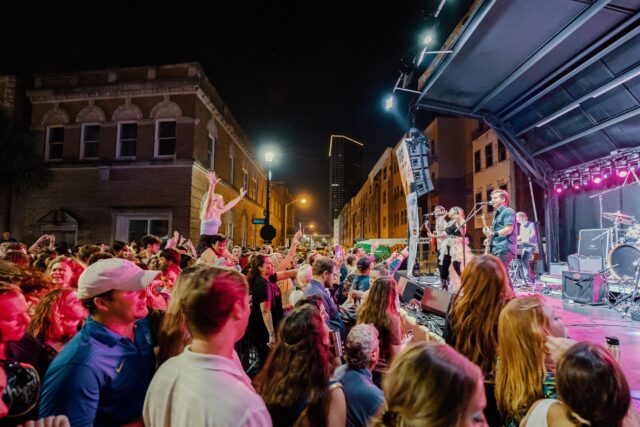
The Flamethrowers perform in downtown Lake Charles during Chuck Fest, October 2019. Photo by Chad Moreno / Killer Photography.
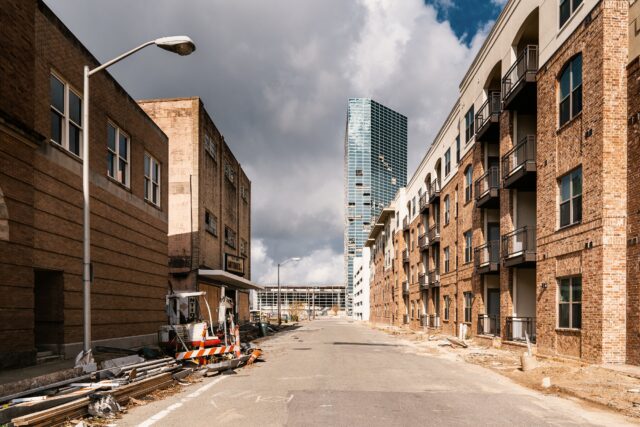
A stretch of downtown near the Chuck Fest stage site after Hurricane Laura. Photo by Chad Moreno / Killer Photography.
Hunter, who was elected in 2017 after Randy Roach’s seventeen-year tenure, has worked to foster public-private partnerships around local events and development. Much of the city’s recent growth is tied to the dominant petrochemical industry, which has announced more than $100 billion in local projects since 2012, and casino-centric tourism. These revenue streams can seem at odds with a creative scene, particularly one with a raised environmental conscience, but the cultural leadership in Lake Charles sees opportunity there, given the potential for grants, sponsorships, and jobs. Steady salaries support up-and-coming artists, said Devan Corbello, executive director of the Arts and Humanities Council of Southwest Louisiana. “And [for the industries], the arts help give employees and their families—both locals and those who move here—a better quality of life. It’s a generous cycle for our community.” Still, Hunter hopes to complicate that cycle, provoking new voices and a more diverse economy that does not see-saw with the price of oil. “Quite bluntly, I want Lake Charles to grow,” he said, “I want to welcome new people into our city. We can embrace what has always made us great while we evolve and progress. This has got to be a community effort saying, ‘This is what we want for Lake Charles.’”
Musician Jeremy Boudreaux, a native of Iowa (that’s “Io-way,” a town fifteen miles east of Lake Charles) and owner of Village Music School, has been encouraged by the new direction. Before the pandemic, new venues, like breweries Rikenjak’s and Crying Eagle and downtown’s Panorama Music House, were reviving a demand for live, local music. At last October’s Chuck Fest, the daylong outdoor salute to local culture, party rock band The Flamethrowers performed before a city block full of friends, family, and ardent fans.
Artists weren’t leaving home to reckon with where they came from; artists were staying here. “When Nic Hunter had just come to office, he invited me to a meeting at City Hall to learn about my business,” said Boudreaux. He asked, “What can we do to help promote our culture?”
Not much promotion has happened since spring. “I felt coming into 2020 that this area was on the verge of a cultural explosion,” said Corbello, who started his position at the Arts and Humanities Council in December 2019. He spoke of pre-pandemic plans for new cultural events and an artists’ networking group to encourage professional development. “I wanted to help foster that explosion any way I could.” As the strange year dwindled and a vaccine became something to reasonably pin hopes and postponed festivals on, Hurricane Laura intervened. Panorama Music House’s second floor would soon see its brick façade lying on the street below. The roof is gone from Boudreaux’s Village Music School, damaging thousands of dollars of instruments within. These are only two variations on countless tragedies that have taken place throughout southwest Louisiana.
I asked Hunter about the first steps to recovering from this region-wide disaster. “Human life is the most important,” he said. “The safety, security, and health of citizens and city employees.”
But then what?
There’s a tendency, following a natural disaster, to put back everything the way it was as quickly as possible,” said Bob Becker, CEO of City Park in New Orleans. “But if you have a future-oriented plan of who you want to be and how you want to get there, you don’t have to put it all back.” Five months before Hurricane Katrina struck, in 2005, Becker and his colleagues had completed a comprehensive plan for the growth of the 1,300-acre public park. “It had been vetted through the community and contained very specific strategies, goals, and projects.” When funding came through relief agencies, insurance, FEMA, and private donors, the park could immediately act, said Becker: “This is what we want to do. This is where money can be most useful.”In the fifteen years since, the park has raised over $200 million dollars to recover from the devastation and move forward, substantially completing the 2005 plan. “You simply have to have a lot of patience,” said Becker. “It takes a long period of time to recover. Different elements of your community are affected differently. It’s hard to come back. No matter how much you say you want to come back, if you don’t have the wherewithal, you’re not going to quickly recover.”
“We don’t want to shoot from the hip,” said Mayor Hunter. “There will be a lot of eyes on Lake Charles that will see the resilience and strength of this community because of how we respond to this event.” But leave aside the area’s marshlands and live oaks, the sunning gators and gulf birds. Lake Charles is ugly right now, and in no position to house its people however much they want to be here. Art can come from that too.
Visual artists, songwriters, and performers will grapple with Laura for years; for now, expressions of the area’s deeper roots act as a balm. Online I watched The Pine Leaf Boys play their Cajun music in a parking lot while people drove by to grab tarps and water bottles. In the bed of a pick-up truck with an ice chest and a gas canister, a pile of branches twice his height behind him, zydeco musician Rusty Metoyer kicked his cowboy boots and squeezed his accordion. Alone, he covered a song by Kinder musician Willis Prudhomme, who passed away four days after the storm from complications connected to COVID-19. “No sad songs for me,” sang Metoyer, “now that I know what love can be.”
Creative relief has also come from those who understand the high stakes for South Louisiana culture. Jazz Foundation of America and the Grammy’s MusiCares Foundation both offered emergency funds directly to suffering musicians, as did Boudreaux’s personal hero Zachary Richard, the acclaimed Cajun songwriter and poet. “There’s a lot more compassion than I was aware existed,” said Boudreaux.
“People are leaving and that’s okay,” he added. “You have to do what you need to do for your families. But I think we’re poised to come back from this as one of the shining jewels of the Gulf Coast, and I’m gonna be a part of it.”
Stella Miller sees resilience in the city too. “I think we’re moving forward. I think [the mayor’s] heart is in the right place. We need more time to see. But in my mind, I keep saying, ‘Out of this storm, there’s got to be something.’”
Lucie Monk Carter left Lake Charles to attend college, but she never shut the door behind her.
